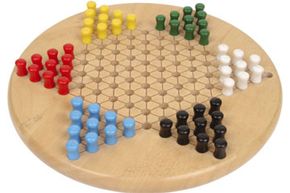Chinese checkers is a fun and easy-to-learn board game that has little to do with traditional checkers and even less to do with China. The board, which can be made from metal, plastic, wood or cardboard, is shaped like a six-pointed star and covered with 121 holes or indentations into which game pieces are placed. It's considered a game of traversal because the basic goal is to be the first player to move his or her pieces from one side of the board to the other.
Despite what its name may suggest, Chinese checkers did not originate in Asia. It was actually derived from a game called Halma, developed by Massachusetts surgeon George Howard Monks in 1885. Halma, which is Greek for "jump" or "leap," had rules very similar to modern-day Chinese checkers, despite the fact that its board was square-shaped. Monk's creation soon caught on, and E.I. Horseman of New York and Milton Bradley of Springfield, Mass., competed to sell the game to a receptive public. After a brief legal battle, Bradley discontinued its Halma line and instead sold a similar game under the name Eckha.
Advertisement
In 1892, German publisher Ravensburger became the first company to produce the game with a star-shaped board, calling it Stern-Halma or "Star Halma." J. Pressman & Co. first marketed the game as "Chinese checkers" in the 1920s, cashing in on America's fascination with Asia and the Middle East after the discovery of King Tutankhamun's tomb in 1922. The name stuck. By the 1930s, Chinese checkers was a craze sweeping across the United States, and the Milton Bradley Company ultimately secured a patent for the game in 1941.
Today, numerous companies produce Chinese checkers for the entertainment of young and old alike. The following pages will explore the rules of the game, a few variations by which it can be played, and some tricks and tips that could give you an edge in your next contest.
Advertisement




